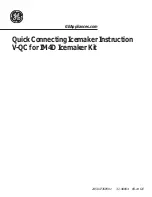
Copyright © 2003-2005 InfoSight Corporation All Rights Reserved
Page 30 of 39
APPENDIX A | LASER SAFETY
LASER SAFETY
04/23/03
Section I: Introduction to Laser Safety
Lasers, like arc welders, are sources of intense light that require certain precautions to insure a safe,
comfortable and compliant working environment. This is especially true since the laser included in this
marking equipment operates in the infrared (invisible) portion of the light spectrum. The enclosure
surrounding the marking area is designed to prevent human exposure to the light emitted by the laser. The
following information covers the procedures taken to design a safe, efficient environment for laser marking
equipment.
Laser products are categorized into one of four classes based upon the power of the laser light that is
accessible to any person during normal operation. These classes range from Class 1, the lowest class
requiring no additional safeguards other than those provided by the manufacturer, to Class 4, the highest
class that requires additional operator and working environment safeguards for safe operation.
Class 1 laser marking systems include enclosures integral to the workstation that are constructed to prevent
human access to the laser beam. Class 1 systems are safe in all working environments; they are installed
and operated as any other industrial machine tool. Class 1 laser systems do not require the use of any
special laser safety equipment by operators or bystanders during their normal operation.
Class 4 laser marking systems do not incorporate protective enclosures. Extra precautions are required.
The LabeLase
1000 Tag Printer complies with Class 1 during normal use because of the numerous
interlocks provided as detailed in section II.
During service and/or alignment the LabeLase 1000 Tag Printer becomes a Class 4 device. Servicing
should be performed only by a
Qualified Laser Service/Safety Technician
! Because of the Class 4
classification, InfoSight will provide such a person to be available to the end user of this marker.
The nominal power output of the laser used is 10 watts, with a maximum peak power output of 30 watts. It
is a C02 infrared (invisible) laser with a wavelength of 10.57 to 10.63 microns. The Radiant energy and the
wavelength are less than Class 1 requirements during normal operation.
Section II: Types of safety interlocks.
There are several types of safety features provided on the InfoSight LabeLase 1000 Tag Printer:
Type 1 includes
mechanical switches
. These switches are located atop the marker and on the rear of the
marker. These switches remove power supplied to the laser marker, as shown in electrical drawings.
Switch A -- Large Red, easily accessible, E-STOP operator Emergency Stop Push Button.
Switch B -- Key switch
Switch C -- On/Off rocker switch
Type 2 includes
optical sensors
. Sensors monitor whether tag material is in place and the marker is able
to move the tag material. These two sensors are monitored by the marking microprocessor.
Type 3 includes
mechanical design
. Here, narrow slots are provided to minimize the release of laser
radiation. The beam path from laser tube to final pass through lens is entirely enclosed in a metal shield,
with suitable material that will absorb the heat produced by the beam emitting from the CO2 laser.
Type 4 includes
Password
Security access.
The Software requires a
supervisor password
to change
layout of tags or to alter the operating parameters of the marker itself.
The features and precautions described above are designed with the safety of the user in mind. Should you
have any questions or suggestions please contact InfoSight directly.










































